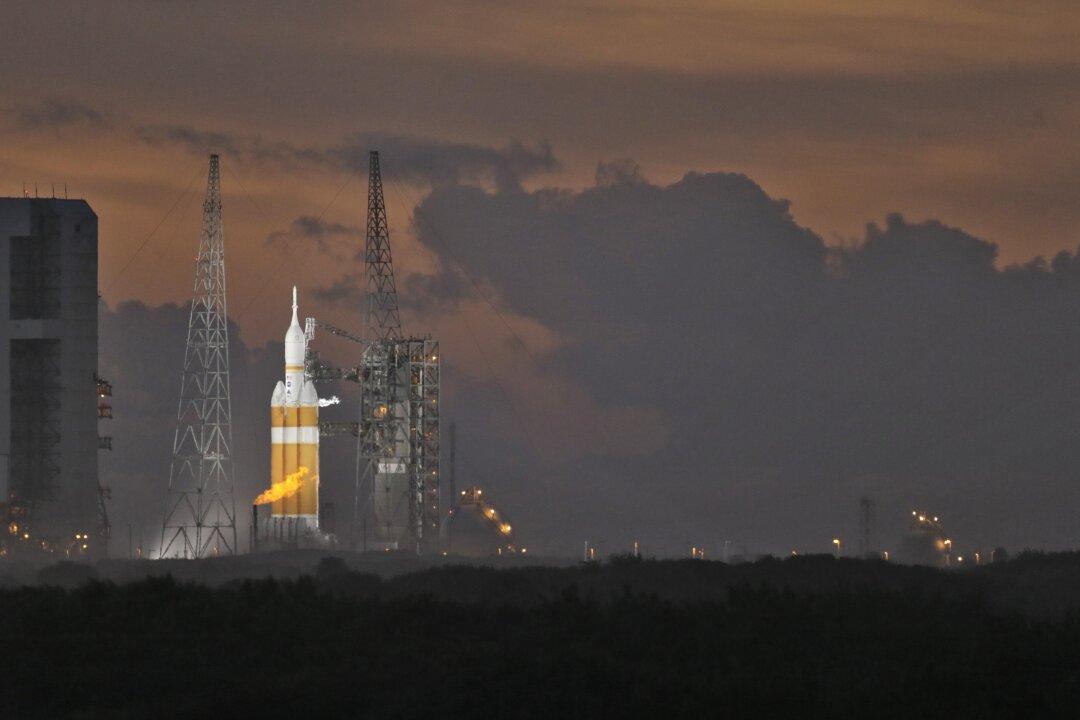CAPE CANAVERAL, Fla.—NASA stood poised to usher in a new era of exploration Thursday with the premier launch of its new Orion spacecraft, but the countdown was repeatedly stalled by gusty wind and then a sticky rocket valve.
After halting the countdown twice because of high wind, NASA pushed ahead, only to be thwarted by a valve in the first-stage booster that failed to close on command with just three minutes and nine seconds to go.
“No show-stoppers,” launch commentator Mike Curie stressed at one point, noting that the team had until midmorning to send Orion on its way.
Launch controllers hustled to check all six of the so-called “fill and drain” valves in the three booster engines of the unmanned Delta IV rocket, in hopes of getting one last chance Thursday morning to launch.
It’s the first attempt to send a spacecraft capable of carrying humans beyond a couple hundred miles of Earth since the Apollo moon program.
The ultimate goal, in the decades ahead, is to use Orion to carry people to Mars and back.
For now, NASA’s new countdown clock was getting a workout: First a stray boat in the danger zone halted the countdown, then gusty winds repeatedly stalled the count with less than four minutes to go.
NASA anticipated 26,000 guests for the historic send-off — the roads leading into Kennedy Space Center were packed well before dawn — and the atmosphere was reminiscent of the shuttle-flying days. “Go Orion!!” urged a hotel billboard in nearby Cocoa Beach.
Curie noted Thursday was the 16th anniversary of the launch of the first U.S. piece of the International Space Station, by shuttle Endeavour. “That was the beginning of the space station, and today is the dawn of Orion,” he said.
Orion is aiming for two orbits on this inaugural run. On the second lap around the home planet, the spacecraft should reach a peak altitude of 3,600 miles, high enough to ensure a re-entry speed of 20,000 mph and an environment of 4,000 degrees. Splashdown will be in the Pacific off the Mexican Baja coast, where Navy ships already are waiting.
NASA’s Mission Control in Houston was all set to oversee the entire 4½-hour operation once the rocket was in flight. The flight program was loaded into Orion’s computers well in advance, allowing the spacecraft to fly essentially on autopilot. Flight controllers could intervene in the event of an emergency breakdown.
The spacecraft is rigged with 1,200 sensors to gauge everything from heat to vibration to radiation. At 11 feet tall with a 16.5-foot base, Orion is bigger than the old-time Apollo capsules and, obviously, more advanced. As NASA’s program manager Mark Geyer noted, “The inside of the capsule is totally different.”
NASA deliberately kept astronauts off this first Orion.
Managers want to test the riskiest parts of the spacecraft — the heat shield, parachutes, various jettisoning components — before committing to a crew. The earliest Orion might carry passengers is 2021; asteroids are on the space agency’s radar sometime in the 2020s and Mars, the grand prize, in the 2030s.
Lockheed Martin Corp., which is handling the $370 million test flight for NASA, opted for the powerful Delta IV rocket this time around. Future Orion missions will rely on NASA’s still-in-development megarocket known as SLS, or Space Launch System. The first Orion-SLS combo launch is targeted for 2018.
NASA’s last trip beyond low-Earth orbit in a vessel built for people was Apollo 17 in December 1972.
“It’s a thrilling prospect when you think about actually exploring the solar system,” space station commander Butch Wilmore said from orbit as the Orion countdown entered its final hour. “Who knows where it will take us, who knows where it will go. We'll find out as time goes forward, but this first step is a huge one.”
NASA’s new countdown clock got a workout Thursday morning. First a stray boat in the danger zone halted the countdown, then gusty winds held everything up with less than four minutes to go. A new launch time was set nearly an hour later, only to be held up again by winds.





